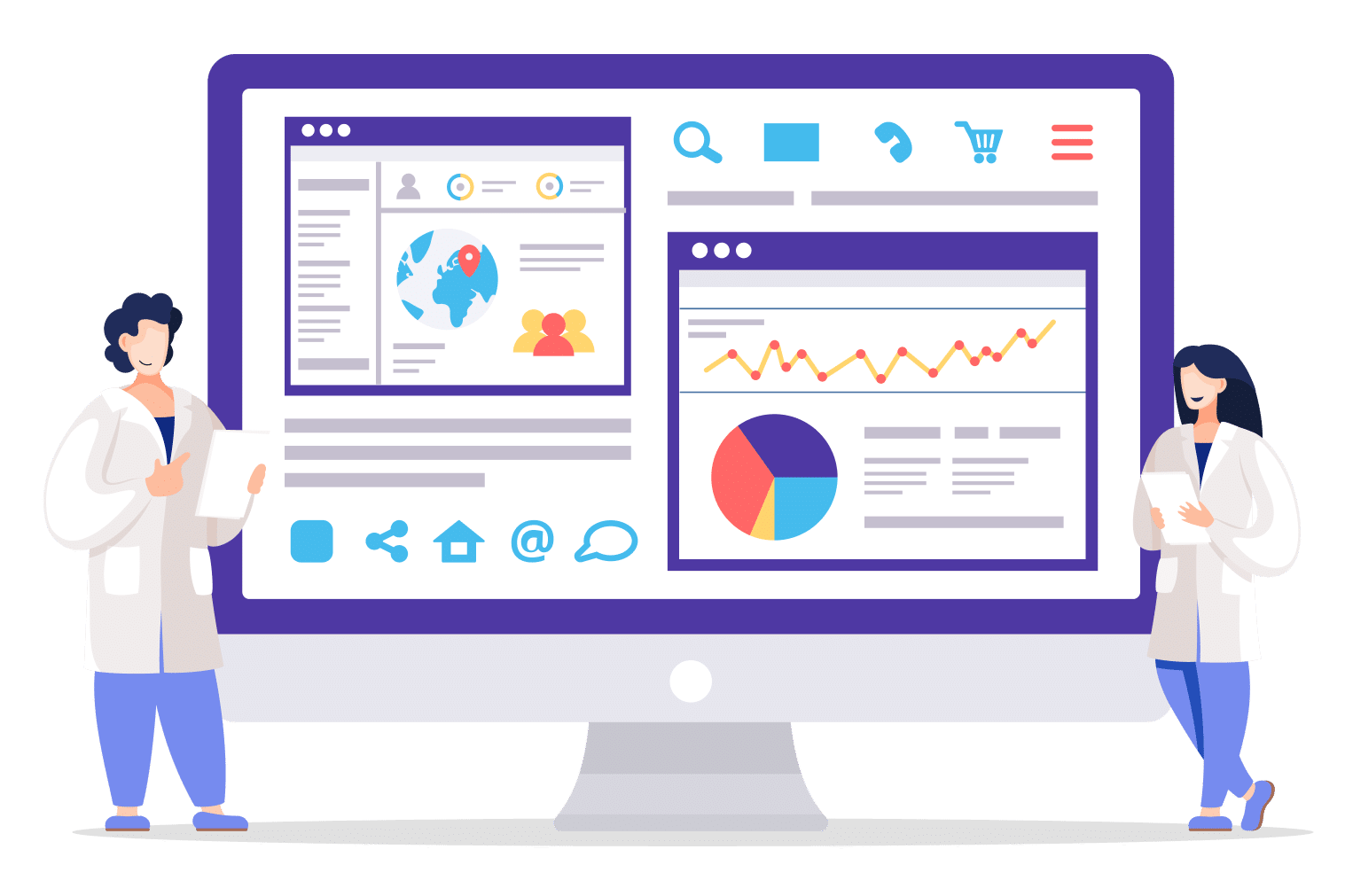
Everything today runs on data. From shopping habits to entertainment choices, industries are driven by the insights they can pull from data — and healthcare is no different. Hospitals and clinics generate huge amounts of information daily, but many still find it challenging to make sense of it all.
Healthcare dashboards offer a solution by turning raw data into clear visuals. They let you see what’s happening across your facility in real-time, from patient admissions to staff schedules. Instead of sorting through spreadsheets or reports, a dashboard brings all your key metrics together in one place.
In this article, we’ll break down the types of healthcare dashboards, the important healthcare KPIs to keep an eye on and how to build a dashboard that works for you. If you’re looking to make your healthcare data work harder and smarter, keep reading.
A healthcare dashboard is a tool that consolidates critical data from across a healthcare facility into one visual platform. Think of it as a command centre — whether it’s tracking patient numbers, monitoring staff availability, checking the status of key resources or assessing revenue numbers, a dashboard brings all of these insights into one place.
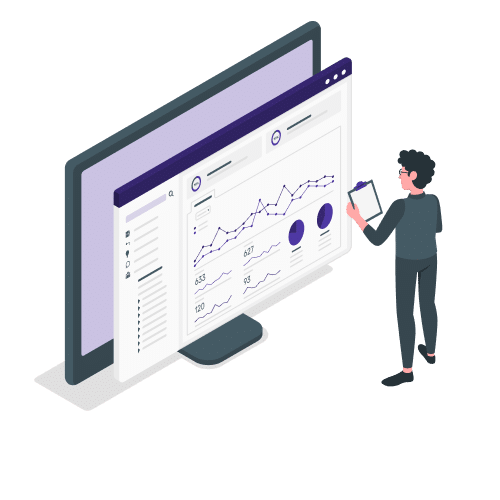
In simple terms, a healthcare dashboard turns complex data into easy-to-read visuals, like charts, graphs and real-time indicators. This means that healthcare administrators, clinicians and analysts don’t need to sift through reports or multiple systems. Instead, they can make quick, informed decisions at a glance.
Why are healthcare dashboards essential?
Centralised information: Eliminates the need to jump between systems, putting all essential data at your fingertips
Real-time updates: Allows teams to respond quickly to urgent needs, like bed availability or staffing shortages
Improved efficiency: Cuts down on manual reporting and data entry, freeing up staff to focus on patient care
Enhanced decision-making: By presenting only the most relevant information, dashboards help teams conduct data analysis and make data-driven choices with confidence
An institution has many hospital departments. Healthcare dashboards are designed to meet specific needs of all the segments. Here are the main types, along with how they can benefit different teams:
Operational dashboards are the backbone of daily hospital management. They provide a bird’s-eye view of key metrics that keep the facility running smoothly, such as:
Bed occupancy rates, showing how many beds are available and in use
Patient admissions and discharges, helping track the flow of patients
Resource allocation, ensuring the right people are in the right places at the right time
For instance, if a sudden influx of patients occurs, this dashboard can immediately flag capacity issues, allowing for quick decisions like reassigning staff or expediting discharges. They help administrators streamline workflows, improve turnaround times, avoid resource wastage and operational performance.
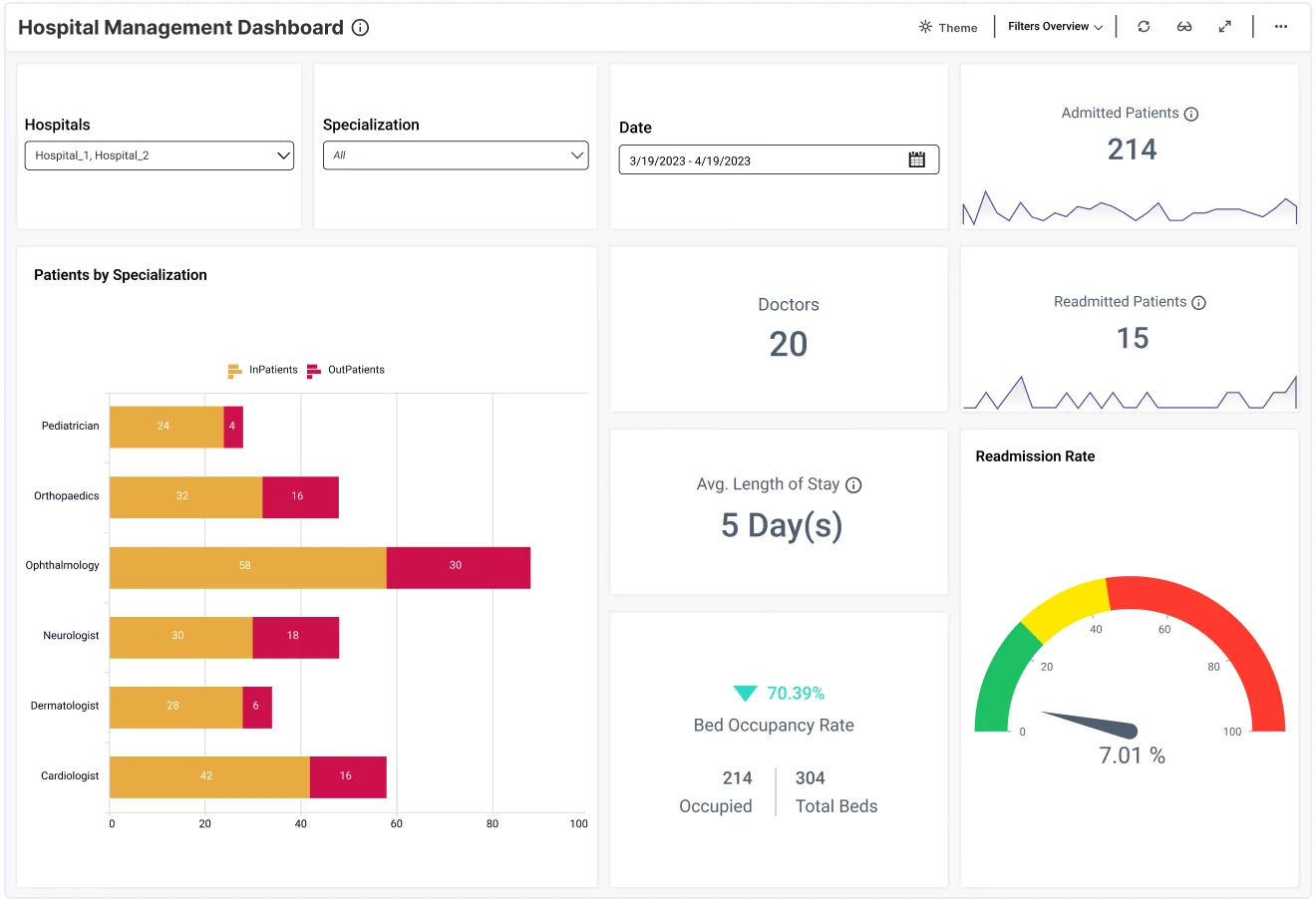
Clinical dashboards are built for healthcare providers who focus on delivering patient care. These dashboards emphasise clinical performance metrics, such as:
Patient outcomes, giving insights into recovery rates or complications
Infection rates, helping monitor and prevent the spread of hospital-acquired infections
Adherence to clinical guidelines, ensuring treatments follow best practices
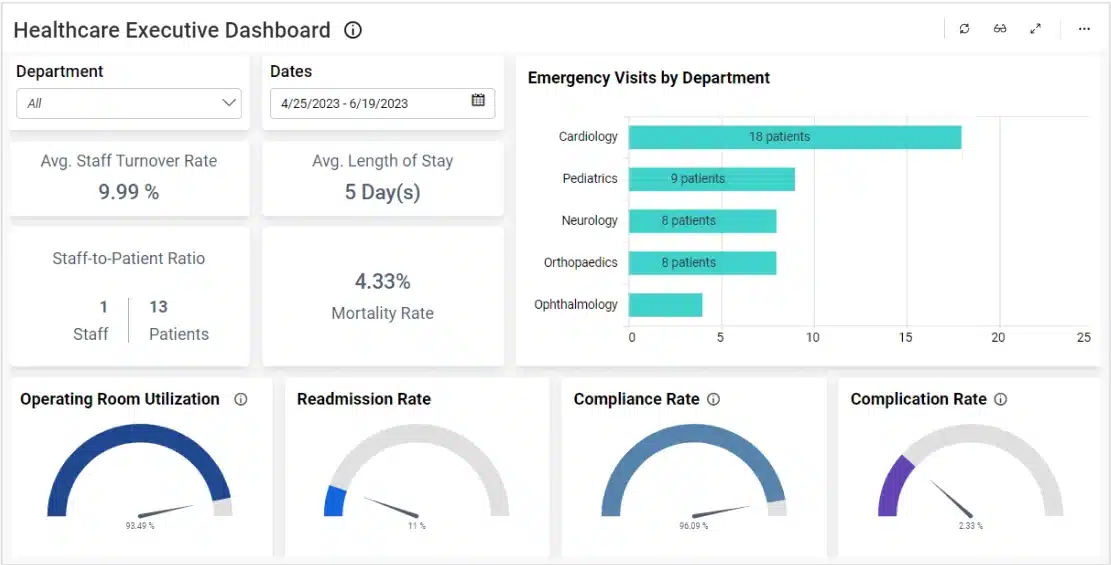
Imagine a hospital tracking readmission rates for heart surgery patients. A clinical dashboard could identify patterns or reasons behind frequent readmissions, enabling clinicians to tweak procedures or post-discharge care plans. These dashboards are vital for enhancing patient care and maintaining high-quality treatment standards.
Running a healthcare facility isn’t just about care; financial health is equally important. Financial dashboards consolidate data related to revenue, expenses and billing, such as:
Revenue cycles and operating revenue, showing income from patient care services
Claim statuses, tracking pending, approved or denied insurance claims
Operating costs, identifying areas where spending can be optimised
For example, a clinic might notice a high rate of claim denials via this dashboard. By digging deeper, they can pinpoint why – perhaps errors in coding or documentation – and address the issue to improve cash flow. Financial dashboards, often developed through outsourced software partnerships, are key for maintaining profitability and long-term sustainability.
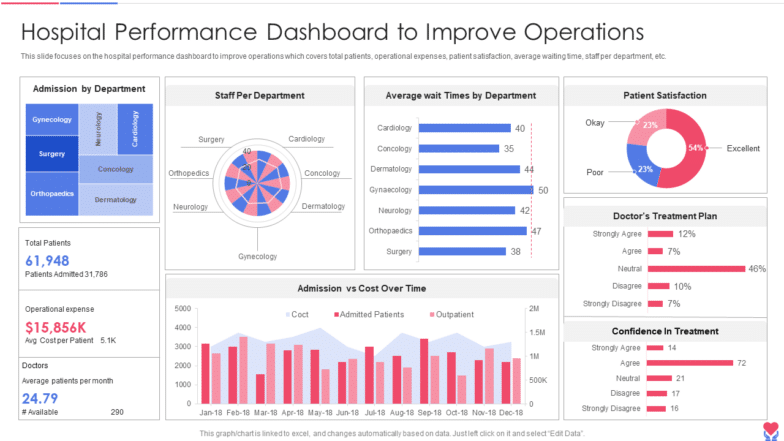
Patient satisfaction isn’t just a nice-to-have; it’s a must-have in competitive healthcare. These dashboards help facilities keep an eye on what patients think by showing data like:
Feedback scores collected through surveys
Complaints about wait times, communication or amenities
Areas of improvement based on patient comments
For instance, if feedback indicates long waiting times in outpatient departments, management can act swiftly, perhaps by adding more staff during peak hours. Such dashboards ensure the patient’s voice is heard and guide efforts to improve the overall experience.
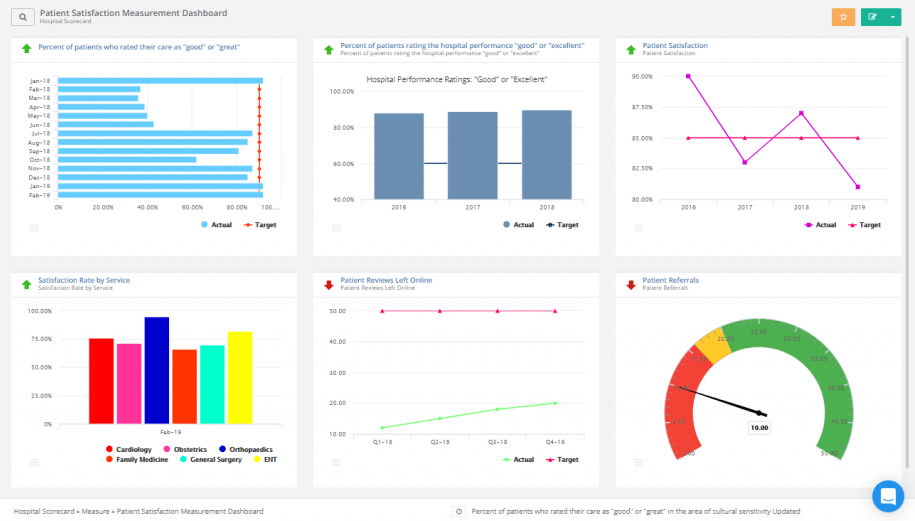
Now that you understand why healthcare dashboards are important, here are some healthcare KPIs to help you understand exactly what they track:

Patient satisfaction is a direct reflection of the quality of care provided. Dashboards often include scores derived from surveys that measure factors like:
The overall patient experience, such as cleanliness and comfort
Communication with doctors and nurses, ensuring clear and compassionate care
Wait times, which can significantly impact patient perceptions
High satisfaction scores indicate that the facility meets or exceeds patient expectations, while low scores highlight areas needing immediate attention.

Readmission rates are a key metric for assessing the effectiveness of care provided. They measure the percentage of patients who return within a specific period after discharge, often due to complications or insufficient follow-up. For example:
Monitoring readmission rates for specific conditions, like heart failure or pneumonia
Identifying gaps in discharge instructions or post-care support
Lower readmission rates usually mean better outcomes and cost savings for the facility.

The ALOS measures the average time a patient spends in the hospital, from admission to discharge. This KPI balances efficiency and care quality by focusing on:
Reducing delays caused by administrative processes or slow diagnostics
Ensuring patients aren’t discharged prematurely, which could lead to readmissions
Tracking ALOS helps facilities optimise patient flow and allocate resources more effectively.

This KPI monitors how many beds are occupied versus available at any given time. High occupancy rates might signal efficient use of resources, but excessive rates could lead to:
Strained staff workloads, risking burnout and errors
Longer waiting times for incoming patients
By maintaining a balance, healthcare providers ensure better patient outcomes and staff well-being.

Healthcare relies heavily on its workforce, so tracking staff performance is vital. Dashboards often include KPIs like:
Staff-to-patient ratios, ensuring adequate coverage across departments
Attendance and punctuality, which impact overall efficiency
Employee satisfaction scores, helping reduce turnover and improve morale
A motivated, well-supported team directly contributes to better patient care.
These KPIs ensure the financial health of the organisation by focusing on:
Revenue cycle efficiency, tracking billing, claims and collections
Cost per patient, helping identify areas of excessive spending
Profit margins, ensuring the facility remains sustainable
Tracking these metrics helps facilities stay financially stable while delivering high-quality care.
Quality care isn’t just about treatment – it’s also about preventing harm. Dashboards monitor critical safety KPIs such as:
Infection rates, like catheter-associated infections or surgical site infections
Incident reports, including patient falls or equipment malfunctions
These metrics ensure compliance with safety standards and build trust with patients.
This KPI measures how well patients follow prescribed treatment plans, which is crucial for positive outcomes. For example:
Tracking medication adherence among chronic disease patients
Monitoring follow-up appointment attendance rates
Healthcare dashboards are powerful tools, but their effectiveness depends on how well they are tailored to the unique needs of your institution. Building or acquiring the right dashboard involves understanding your requirements, budget and technical capabilities. Here are the key options for obtaining healthcare dashboards:
For institutions with specific needs, custom-built dashboards are often the best choice. These are designed from scratch to integrate seamlessly with your existing systems and workflows.
Who builds them?
In-house IT teams, if you have a skilled development team
Software development firms specialising in healthcare solutions
Benefits
Complete customisation based on your facility’s KPIs, processes and goals
Direct integration with your electronic health record (EHR) or hospital management system (HMS)
Scalability to accommodate future growth
Challenges
Higher initial costs and longer development time
Requires ongoing maintenance and updates
Many software vendors offer a ready-made healthcare performance dashboard designed for common needs like operational, clinical or financial monitoring.
Examples of vendors
Power BI by Microsoft, known for its flexibility and integration capabilities
Tableau, which offers advanced data visualisation and interactive dashboards
QlikView, focusing on analytics and real-time data tracking
Benefits
Faster implementation compared to custom builds
Often comes with pre-defined templates for healthcare-specific KPIs
Lower initial cost than custom solutions
Challenges
Limited customisation, which might not meet all your unique needs
May require training for your team to use effectively
Software-as-a-Service (SaaS) platforms are gaining popularity for their ease of use and scalability. These cloud-based tools allow you to create and manage dashboards without heavy technical expertise.
Examples of SaaS tools
Zoho Analytics, offering intuitive dashboards and healthcare-specific features
Sisense for Healthcare, tailored for large data sets and predictive analytics
Domo, a versatile tool that integrates with multiple data sources
Benefits
No need for on-premise hardware or significant IT resources
Regular updates and support from the provider
Subscription pricing, making it budget-friendly for smaller institutions
Challenges
Data security concerns, as sensitive information is stored in the cloud
Ongoing costs due to subscription models
Many EHR providers now include built-in dashboards as part of their systems. These are often designed to work specifically with the provider’s platform, streamlining data collection and analysis.
Examples
Epic Systems, which provides dashboards with advanced analytics tools
Cerner, offering dashboards for operational and clinical insights
Benefits
Seamless integration with your patient data
Reduces the need for separate software and training
Optimised for compliance with healthcare regulations
Challenges
Limited flexibility if you need additional features beyond what’s offered
High dependency on the EHR provider
If your institution has unique requirements but lacks the resources to build or choose a solution, consulting firms can bridge the gap.
What they offer
Analysis of your needs to recommend the best approach
Hybrid solutions combining custom and pre-built dashboards
Implementation support and training
Examples
Deloitte and PwC offer healthcare analytics consulting services
Boutique firms specialising in healthcare IT, such as Meditech Solutions
Benefits
Tailored guidance without the need for internal expertise
Faster deployment with professional oversight
Challenges
Higher costs for consulting services
Now that you know:
How healthcare dashboards help you in efficient hospital management
Their examples and types
And how you can build one for your healthcare organisation
It’s time for you to take action!
So if you’re seriously interested in a healthcare dashboard, here’s what you need to do:
Understand the scaling of your institution
Browse through the available options
Choose the one that best fulfills your needs
But if by reading this blog, you have come to an understanding that you were looking for something more than just a dashboard, we can help!
Telecrm is an all-in-one healthcare CRM software designed for healthcare professionals to manage patient care and streamline their operations with the help of features like customisable workflows, patient interaction management, custom dashboards and much more!


© Copyright 2025 Telecrm.in - All Rights Reserved • Privacy Policy • T&C
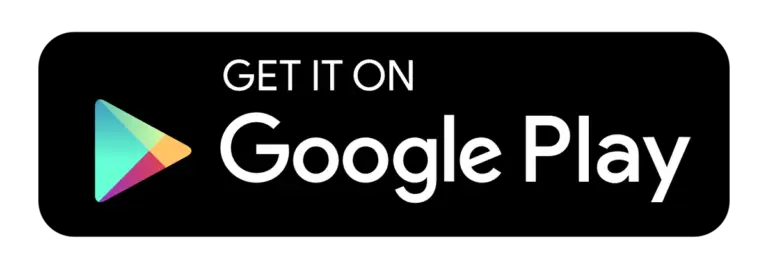

© Copyright 2025 Telecrm.in - All Rights Reserved • Privacy Policy • T&C